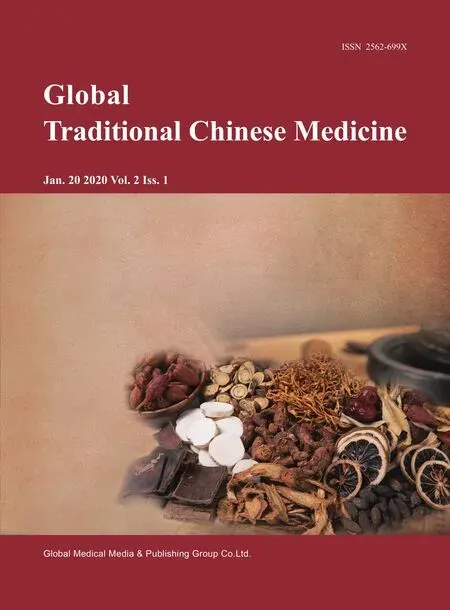Study on medicinal properties and pharmacological actions of ulcerative colitis from Chinese Medical Code
2020-11-17YaoBaiShaohuiWangJiayongZhangXiaobingMaXixiaWang
Yao Bai, Shaohui Wang, Jiayong Zhang, Xiaobing Ma, Xixia Wang
1 Shaanxi University of Chinese Medicine, Xianyang, Shaanxi Province, China
2 Affiliated Hospital of Shaanxi University of Chinese Medicine, Xianyang, Shaanxi Province, China
3 Second Affiliated Hospital of Shaanxi University of Chinese Medicine, Xianyang, Shaanxi Province,China
4 Dingxi Hospital of Traditional Chinese Medicine, Dingxi, Gansu Province, China
Abstract
Key words: dysentery; ulcerative colitis; medicinal property; pharmacological action; prescription
Introduction
Ulcerative Colitis (UC) is a disease that similar to intermittent dysentery, and it has been regarded by WHO as a modern refractory disease because of its chronic and recurrent attacks, difficulty in treatment and possibility of cancerization.The mobility and morbidity of UC have obvious difference among different regions and races,and reach a peak in white people living in north America and north Europe, however, Chinese people have a rising mobility tendency to UC in recent decades[1].Dysentery is a disorder mainly characterized by an increase of bowel movements, abdominal pain, tenesmus, stools containing blood and mucus[2].In ancient times, Chinese doctors have original ideas about the dysentery diagnosis and treatment, they have concluded many experienced medications.For example, Shen Nong’s Herbal recorded thatChishizhi(Halloysitum Rubrum) has a function to treat dysentery with blood and mucus; Ge Hong in East Jin Dynasty came up with the moxibustion method of“2 Cun under heart area, 14 moxa cones treating can stop the frequent stool”; Sun Simiao in Tang Dynasty treated the vomiting and dysentery from cholera with the prescription ofBanxia(Pinellia ternate),Renshen(Ginseng),Fuzi(Lateralis Preparata),Ganjiang(Zingiber Dried Ginger) andJiegeng(Platycodon Grandiflorum); Liu Wansu in Jin and Yuan Dynasty put forward the argument of “tenesmus will be stopped while qi circulating, mucus will be disappeared while blood invigorating”, then he invented the famous formula called Shao Yao Tang (Peony Decoction); Wu Shiying in Qing Dynasty dwelt on the success and failure in dysentery treatment at all times and all over the word, and supplemented with his own clinical practice, finally he wrote the famous authoritative work called Dysentery Distinguish.The medicinal properties of Chinese medicine include the aspects of four-nature, five-flavor, meridian tropism and four directions of ascending, descending, floating and sinking.These properties can embodies Chinese medicinal actions, characteristics, functional parts and working tendency.Since the holism researches of “Characteristic-Flavor-Meridian Tropism” in Chinese medicine could be used for formula practice, investigations on the medicinal properties combination have an unique advantage in clinical treatment[3].Revealing medicinal properties and pharmacological actions in ancient dysentery treatment formulas through association analysis, we can provide the prescription basis for UC’s syndrome differentiation and treatment.
Materials and Methods
Data sources
Based on the Chinese Medical Code[4](5thedition,published by Hunan Electronic and Audio-Visual Publishing House), this study took “Famous Formula”part in this book as the subject and screened out 147 formulas after primary classification and statistics, by retrieving key words “Li”, “Zhixia” and “Changpi” (Chinese meanings related to dysentery).Among the 147 formulas,there are 140 formulas related to “Li”, 4 formulas related to “Zhixia” and 3 formulas related to “Changpi”.Seven repeated formulas and five formulas for external use were eliminated,finally we acquired 135 eligible formulas totally.
Research criteria
Inclusion criteria
① The formula has a clear medicinal combination, and the major function is to treat dysentery (Liji, Zhixia and Changpi); ② For oral formulas only, the pill, pellet,powder, decoction and paste are available.
Exclusion criteria
① Formula with repeated name or same combination;② Single medicine meaningless for formula combination study; ③ Formula without indications to medicinal combination or symptoms; ④ Formula with ambiguous expression or non-conformity to TCM treatment of dysentery related symptoms; ⑤ Formula without clear formula name.
Data specification
Before this study starts, the nick name and processing name of Chinese medicines were standardized and recorded according to the Chinese Materia Medica[5].Since different processing methods may lead to different functions, the specific name of some medicines shall be determined by the research group after discussion.We eliminated the medicines that were not recorded in the Chinese Materia Medica[5].In the descriptions of nature and flavor such as slight cold and strong pungent, the adjunct words “slight” and “strong” shall be deleted; for the words of slight warm, strong warm and slight sour,simplifying them as “warm” and “sour”.Nouns about pharmacological actions of Chinese medicines shall be standardized and determined by the research group after discussion based on Pharmacology[6].
Research methods
Database construction
Chinese medicines from dysentery related formulas in ancient times were collected and the database was built by using Microsoft Office Excel 2016.To guarantee the accuracy of the data, one person input data and the other person check data.
Construction of medicinal properties database of high frequency medicines: High frequency medicines used by ancient doctors for treating dysentery were selected,marking “1” for medicines which corresponding to medicinal property and marking “0” for noncorresponding medicinal property.
Construction of pharmacological action database of high frequency medicines: For one combination of medicinal properties, high frequency medicines involved in this combination were selected, according to pharmacologic actions in Modern Chinese Medicine Dictionary[7]and Pharmacology of Chinese Materia Medica[8], marking “1”for medicines with expected pharmacologic actions and marking “0” for no actions.
Determining high frequency medicines and their properties, flavors and meridian tropism
After sorting and statistically analyzing Chinese medicines from dysentery related formula in ancient times, high frequency medicines were determined by the research group.The four-nature,five- flavor and meridian tropism of high frequency medicines were summarized, sorted and analyzed according to the standards formulated in Chinese Materia Medica[5].
Combination of medicinal properties of high frequency medicines
A combination with three elements of property, flavor and meridian tropism is set up as a basic medicinal property unit.For example, the property, flavor and meridian tropism ofBaishao(White Peony Root) are cold, bitter and sour, belongs to liver and spleen meridian, so there are four methods arranged in accordance with medicinal properties combination, that is, cold-bitter-liver, coldsour-liver, cold-bitter-spleen, and cold-sour-spleen.In this study, we modified the combination rules are: simplifying the small intestine meridian to “small”, large intestine meridian to “large”, pericardium meridian of “pericardium”,triple energizer meridian to “triple” and bladder meridian to “bladder”.
Association analysis
An association analysis was performed among medicinal properties and pharmacological actions of high frequency medicines by using Apriori module in IBM SPSS Modeler Version 18.0 software.The minimum of three medicines was selected for the analysis of medicinal properties.In the analyzing process, the setting of minimum confidence,minimum support and anterior number were decided by the research group after discussion based on relative literatures and reports[9-11].
Results
Frequency of Chinese medicine
There are 186 Chinese medicines acquired and 979 times used after data sorting and statistics analyzing for ancient formula in treatment of dysentery related diseases.After discussion, the criteria for high frequency medicine is determined upon the usage of over 10 times and 7% frequency, so 26 medicines (Table 1) were acquired, of whichHuanglian(Golden Thread),Gancao(Liquorice Root),Danggui(Chinese Angelica),Muxiang(Common Aucklandia Root) andBaishao(White Peony Root) were the topfive medicines.
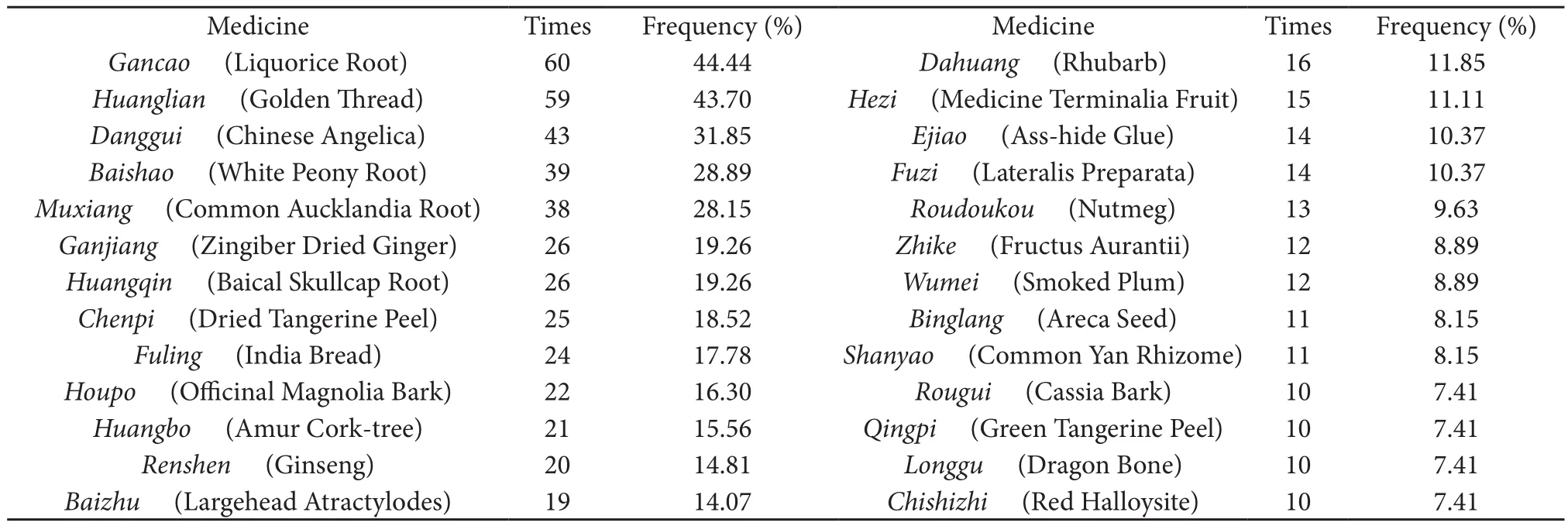
Table 1 High frequency medicines for dysentery treatment in ancient doctors
Properties, flavors and meridian tropisms of high frequency medicines and combinations of medicinal properties
After statistics, the major natures of high frequency medicines are warm, mild and cold; the major flavors are bitter, sweet and pungent; meridian tropism are involved in spleen, stomach, heart, liver, lung, kidney and large intestine meridian.Based on these elements, we made permutation and combination in accordance with the order of four natures (cold, hot, warm, cold and mild),five flavors (sour, bitter, sweet, pungent, salt, astringent and light) and meridian tropism (heart, liver, spleen,lung, kidney, small intestine, large intestine, stomach, gall bladder, urinary bladder, triple energizer, pericardium),then acquired the combinations of medicinal properties accounting for over 5% frequency from high frequency medicines, namely pungent-warm-spleen, bitter-warmspleen, bitter-cold-spleen, pungent-warm-large, pungentwarm-stomach, sweet-mild-lung, and sweet-mild-kidney(Figure 1, Table 2).
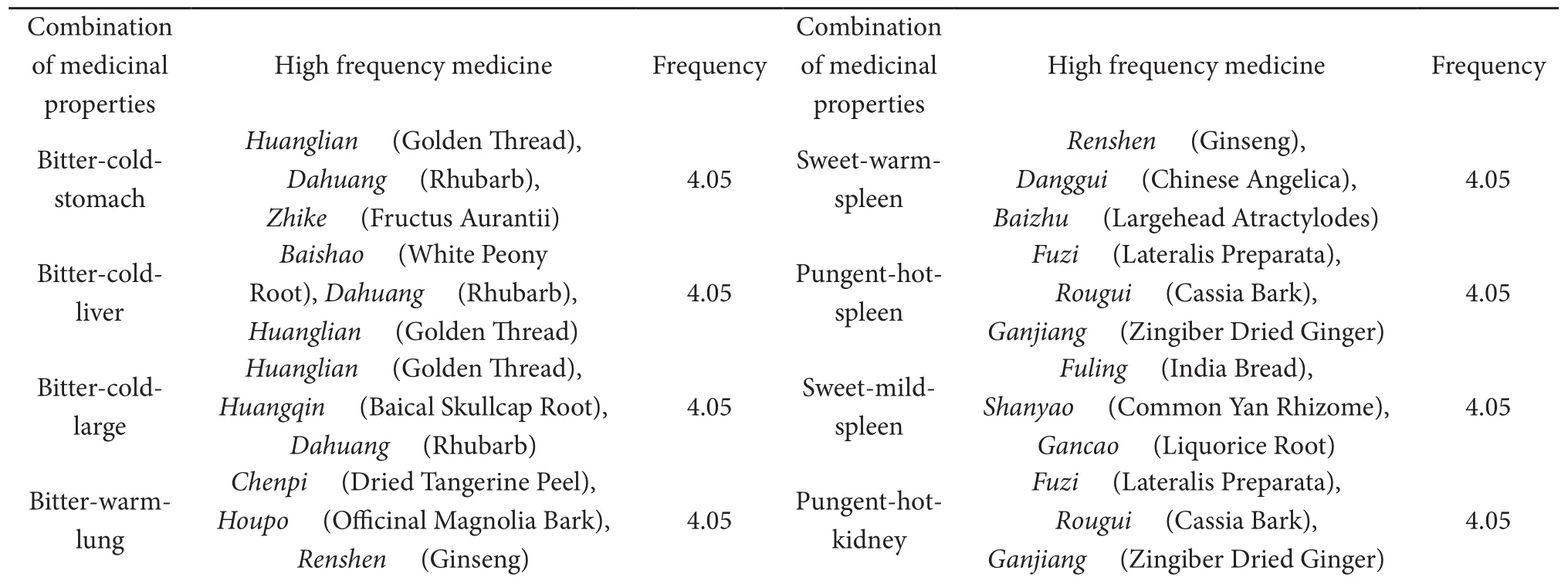
Table 2 Combinations of medicinal properties of high frequency medicines (%)
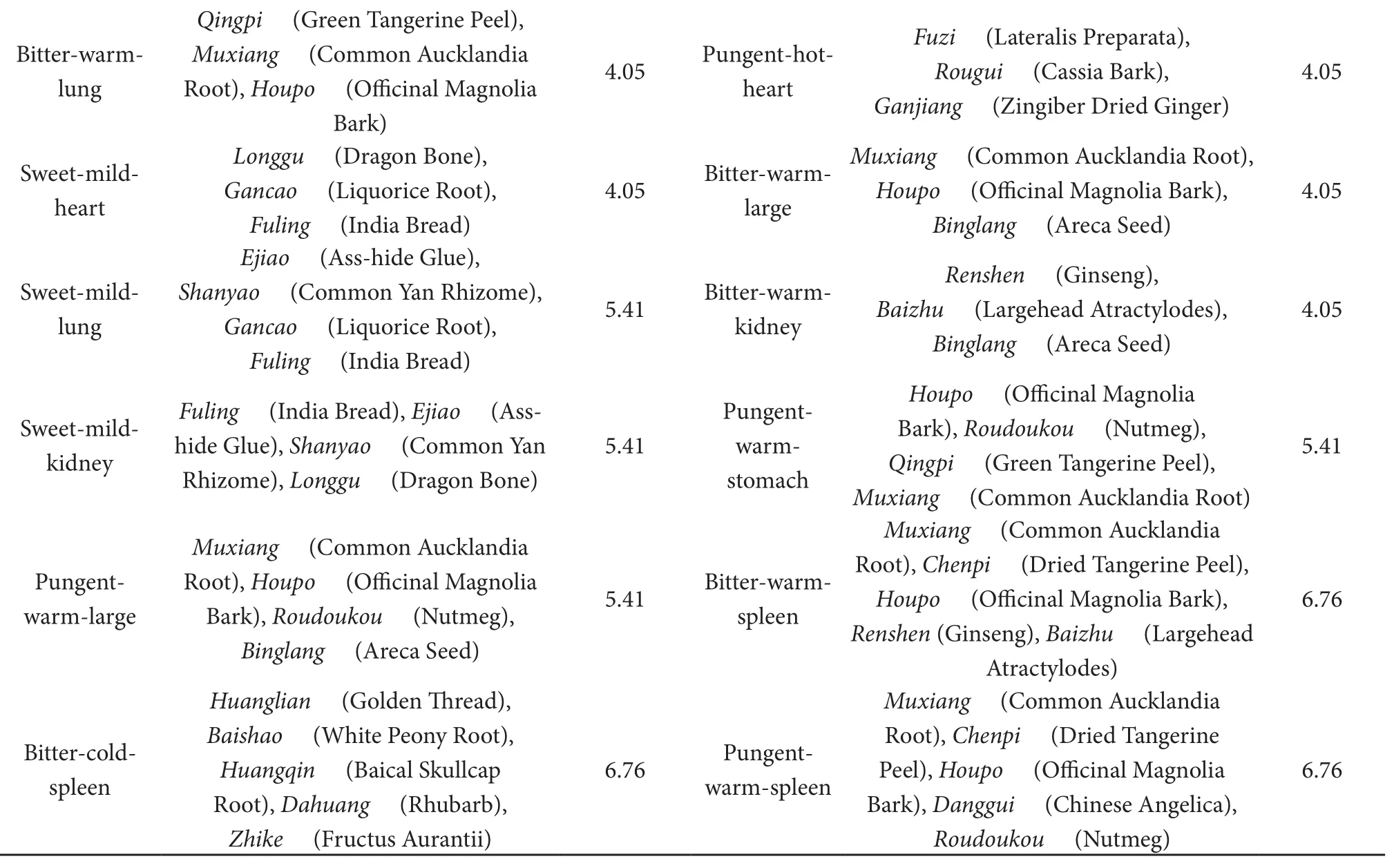
Bitter-warmlung Qingpi (Green Tangerine Peel),Muxiang (Common Aucklandia Root), Houpo (Officinal Magnolia Bark)4.05 Pungent-hotheart Fuzi (Lateralis Preparata),Rougui (Cassia Bark),Ganjiang (Zingiber Dried Ginger)4.05 Sweet-mildheart Longgu (Dragon Bone),Gancao (Liquorice Root),Fuling (India Bread)4.05 Bitter-warmlarge Muxiang (Common Aucklandia Root),Houpo (Officinal Magnolia Bark),Binglang (Areca Seed)4.05 Sweet-mildlung Ejiao (Ass-hide Glue),Shanyao (Common Yan Rhizome),Gancao (Liquorice Root),Fuling (India Bread)5.41 Bitter-warmkidney Renshen (Ginseng),Baizhu (Largehead Atractylodes),Binglang (Areca Seed)4.05 Sweet-mildkidney Fuling (India Bread), Ejiao (Asshide Glue), Shanyao (Common Yan Rhizome), Longgu (Dragon Bone)5.41 Pungentwarmstomach Houpo (Officinal Magnolia Bark), Roudoukou (Nutmeg),Qingpi (Green Tangerine Peel),Muxiang (Common Aucklandia Root)5.41 Pungentwarm-large Muxiang (Common Aucklandia Root), Houpo (Officinal Magnolia Bark), Roudoukou (Nutmeg),Binglang (Areca Seed)5.41 Bitter-warmspleen Muxiang (Common Aucklandia Root), Chenpi (Dried Tangerine Peel),Houpo (Officinal Magnolia Bark),Renshen (Ginseng), Baizhu (Largehead Atractylodes)6.76 Bitter-coldspleen Huanglian (Golden Thread),Baishao (White Peony Root),Huangqin (Baical Skullcap Root), Dahuang (Rhubarb),Zhike (Fructus Aurantii)6.76 Pungentwarm-spleen Muxiang (Common Aucklandia Root), Chenpi (Dried Tangerine Peel), Houpo (Officinal Magnolia Bark), Danggui (Chinese Angelica),Roudoukou (Nutmeg)6.76
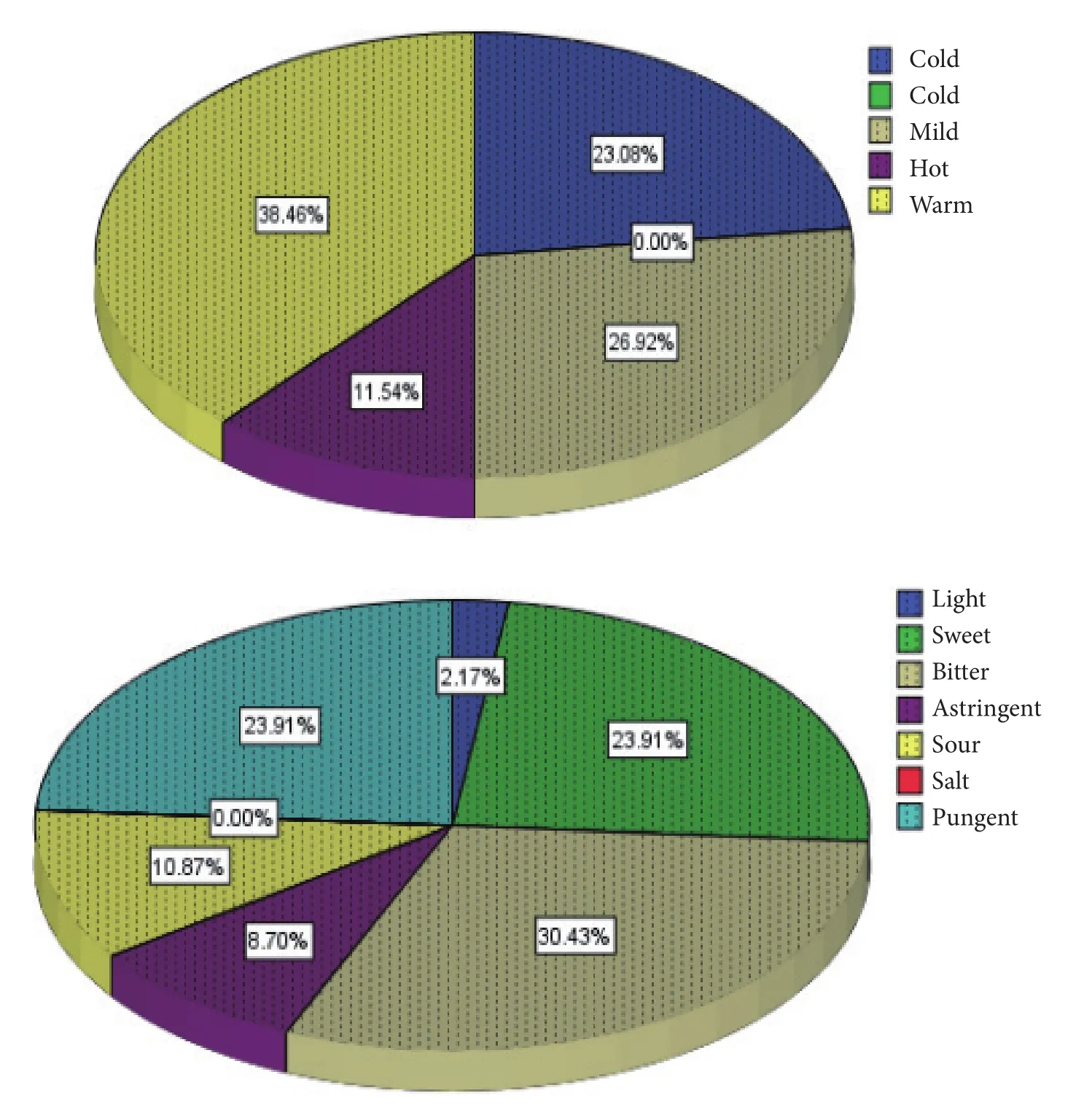
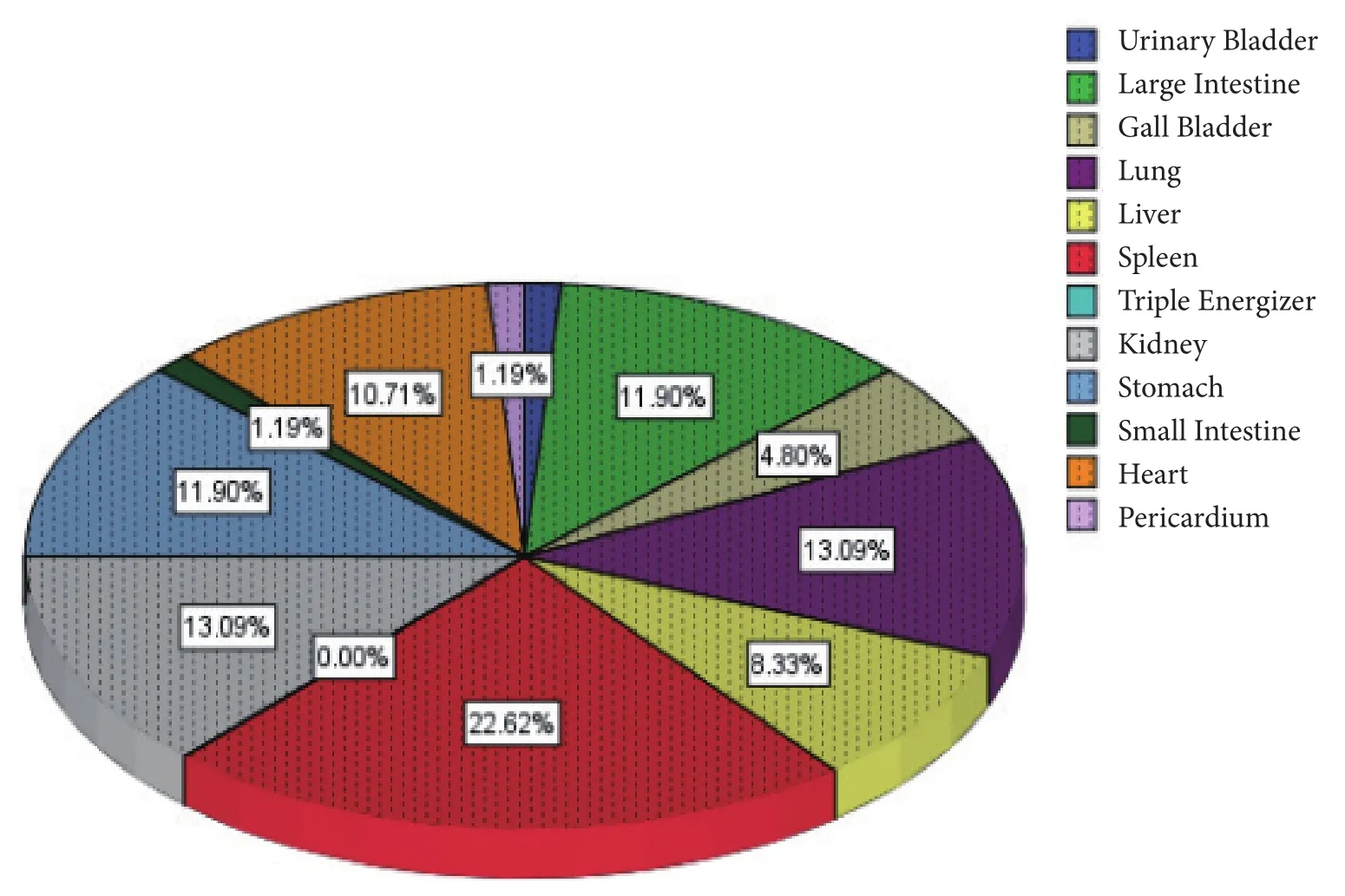
Figure 1 Medicinal properties distribution of high frequency medicines
Association analysis on medicinal properties of high frequency medicines
Association analysis was performed on medicinal properties of high frequency medicines in Apriori module,the minimum support was 30%, the minimum confidence was 70%, and the anterior number was 3.Results represented that the major combinations were sweetwarm-spleen and bitter-warm-spleen (Table 3, Figure 2).Among the high frequency medicines in the combination of warm-bitter-sweet-spleen properties,Renshen(Ginseng)andBaizhu(Largehead Atractylodes) were eligible.

Table 3 Association analysis on medicinal properties of high frequency medicines
Association analysis on pharmacological actions of high frequency medicines
Association analysis was performed on pharmacological actions of high frequency medicines in Apriori module, the minimum support was 30%, the minimum confidence was 65%, and the anterior number was 3.Results represented that the pharmacological actions was embodied in antimicrobial and immune regulation (Table 4, Figure 3).
High frequency medicines eligible for pharmacological actions of both anti-microbial and immune regulation wereGancao(Liquorice Root),Huangqin(Baical Skullcap Root),Huanglian(Golden Thread),Huangbo(Amur Cork-tree),Baishao(White Peony Root),Chenpi(Dried Tangerine Peel),Fuling(India Bread),Wumei(Smoked Plum) andBaizhu(Largehead Atractylodes).
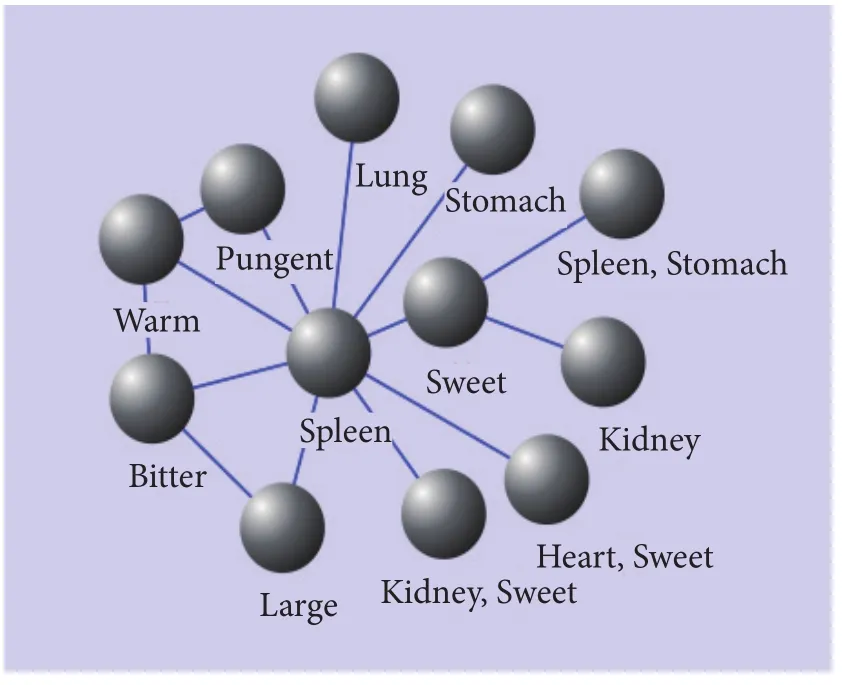
Figure 2 Network of medicinal properties in high frequency medicines
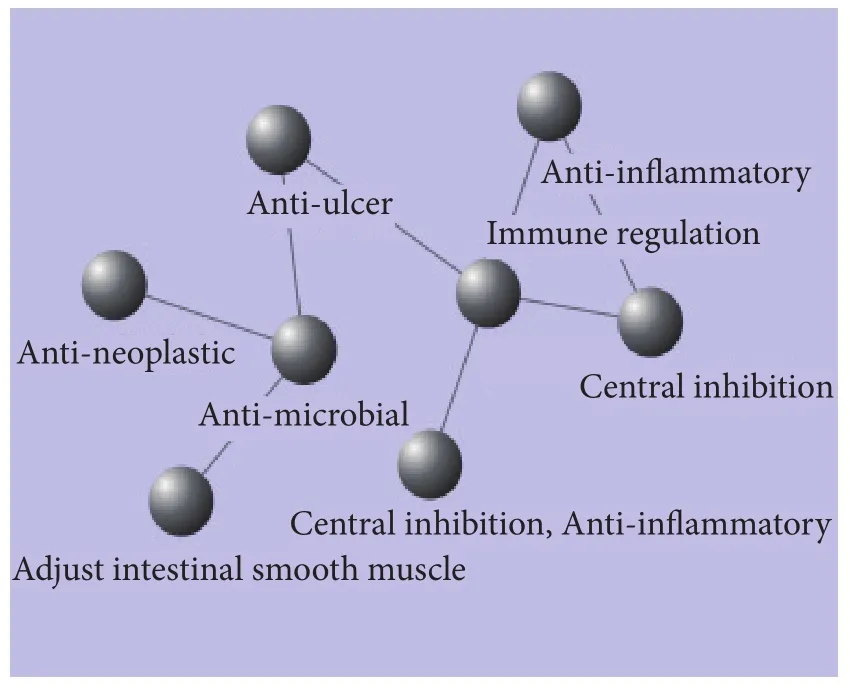
Figure 3 Network of pharmacological actions in high frequency medicines
Discussion
Since the 21stcentury, the rapid development of computer and internet has provided a proper time and condition to data mining in the era of big data.Association analysis is one of the typical data mining technology, it has the functions to identify the frequently appeared attribute value sets from data set and then create the principle to describe an association[12].Researches on ancient literatures with association analysis are becoming more and more popular among medical investigators.With this method, Ji et al[13]had retrieved the diabetes formula from Dictionary of Traditional Chinese Formulas and established the database, subsequently they investigated medication regularity and property through association analysis, and got the conclusion that the compatibility of medicines in treatment of diabetes are mainly applicable for supplementing both qi and yin, clearing heat and purging fire, generating body fluids to nourish lung, this had provide scientific guidance for clinical rational drug use and mechanism explanation.By using association analysis, Wang et al[14]further explored the compatibility rules involving Guizhi by Chinese doctors, which provided objective evidence for clinical safe, effective and rational application of Guizhi, and developed scientific and effective methods for formulating clinical compatibility rules and experimental study.
In this study, data sorting and statistics results showed that the major Chinese medicines used in famous formulas for dysentery from A Dictionary of Chinese Pharmaceuticals areGancao(Liquorice Root),Huanglian(Golden Thread),Danggui(Chinese Angelica),Baishao(White Peony Root) andMuxiang(Common Aucklandia Root).Gancao(Liquorice Root),first recorded in Shen Nong’s Herbal, has the functions of “removing extreme cold and hot in the vital organs of the human body, strengthening bones and muscles, calming the mind, terminating the palpitation,removing the pathogenic factors, improving eyesight and intelligence.Huang praised thatGancao(Liquorice Root) is like a gentlemen with vital qi and mild disposition, he is an intimate friend with harmonious and honest contributions among heart, lung, liver, kidney and spleen, he can help stomach working in the middle of the body and spread the spleen essences to another organs.Moreover, he has an abilities of mental adjustment, qi invigoration and blood circulation.It can be said thatGancao(Liquorice Root)is really a panacea[15]”.Modern pharmacological study demonstrates thatGancao(Liquorice Root) contributes to promote corticotropic hormone-like effects, plays antimicrobial, anti-inflammatory, anti-oxidative role, regulates the immune and promotes gastrointestinal mucosa repairment.Shen Nong’s Herbal indicates clearly thatHuanglian(Golden Thread) is applicable to treat dysentery with abdominal pain; Liao Xiyong recorded the processing method that the combination of wetHuaihua(Flos Sophorae) and fried Huanglian (Golden Thread) treats bloody dysentery[16].The property and flavor ofHuanglian(Golden Thread) are cold and bitter, it has the functions of clearing heat and resolving dampness, purging fire and removing toxin.Huanglian(Golden Thread) withMuxiang(Common Aucklandia Root) can be used to prepare Xianglian Pill (Aucklandia and Coptis Pill) by pounding and mixing with honey, each weighing about 9 grams.Take 20-30 pills each time in empty stomach, dysentery can be treated.In modern researches, this pill acts on signal path of inflammatory related tumor necrosis factor,endothelial white blood cell migration and TRP channel inflammatory mediated pathway[17], it also enhances Bcl-2 mRNA expression and reduce the Bax mRNA expression,ameliorates colonic mucosa impairment and reduces epithelial cell apoptosis in rats with UC[18].Danggui(Chinese Angelica) can improve the systemic metabolism and immunity in the body, also, it has an antibiotic action against bacteria such as dysentery bacillus and hemolytic streptococcus[19].The medicine pair ofBaishao(White Peony Root) andGancao(Liquorice Root) are widely used in treating several pains, their active ingredients are effective in treatment of tumor, nervous system disease,endocrine, nutritional and metabolic diseases, as well as infection and parasitic disease[20].
By analyzing medicinal properties and medicinal combinations of high frequency medicines in ancient dysentery formulas, we found that the properties of Chinese medicines used are predominantly warm; the flavors are mainly pungent, bitter and sweet; meridian tropisms are in spleen and stomach meridians.The association analysis results of medicinal property of high frequency medicines indicated that the major compatibility of high frequency medicines involves herbs benefiting for spleen with sweet or bitter taste and neutral nature, in warm-bitter-sweet-spleen combination pattern,among themRenshen(Ginseng) andBaizhu(Largehead Atractylodes) are eligible medicines.This finding reflected that UC has the pathogenesis characteristics of mixing deficiency and excessiveness, which embodies on spleen and stomach weakness and accumulated heat in intestine.Therefore, in clinical treatment of UC,Renshen(Ginseng)andBaizhu(Largehead Atractylodes) are preferred for prescriptions, of which the sweet flavor can restore deficiency and relax urgency; pungent and bitter flavor can remove dampness and heat in large intestine.
Modern research[21]indicates that the pathogenesis of UC can be concluded that, intestinal mucosa is injured continuously when environmental factors affects genetically susceptible population, and intestinal immune imbalance condition will injure the intestinal mucosal barrier after the enteric microorganism participants.The results from association analysis to pharmacological actions of high frequency medicines indicate that functions of high frequency medicines are mainly reflected on anti-microbial and immune regulation, which are completely consistent with the pathogenesis of UC.The eligible medicines includingGancao(Liquorice Root),Huangqin(Baical Skullcap Root),Huanglian(Golden Thread),Huangbo(Amur Cork-tree),Baishao(White Peony Root),Chenpi(Dried Tangerine Peel),Fuling(India Bread),Wumei(Smoked Plum) andBaizhu(Largehead Atractylodes) are recommended for prescriptions based on the syndrome differentiation treatment of UC.
As a typical method of data mining, association analysis will play an important role in TCM modernization development process.However, this study fails to comprehensively reveal the medication regularity in treatment of all dysentery related diseases in ancient times,due to fewer samples.From this study, our findings are consistent with modern research in UC treatment, with the expectations to provide rational guidance for clinical prescription in treatment of UC.
杂志排行
Global Traditional Chinese Medicine的其它文章
- Clinical observation of Yinchen Jianpi Tuihuang Granule in treatment of 52 cases of neonatal pathological jaundice
- Clinical observation of Xuanfei Conger Decoction combined with auricular point sticking pressure on secretory otitis media and its effect on auricular effusion
- Clinical efficacy of Jiawei Xiaoshui Shengyu Decoction in treating chronic heart failure and its effect on NO and inflammatory factors
- Clinical observation on 48 cases of mild and moderate ulcerative colitis treated with Jiawei Sanren Decoction
- Clinical experience of Professor Huang Yahui on the same treatment for different diseases by applying the method of invigorating spleen and resolving phlegm
- Discussion on the treatment of polycystic ovary syndrome from “spleen” based on intestinal flora
